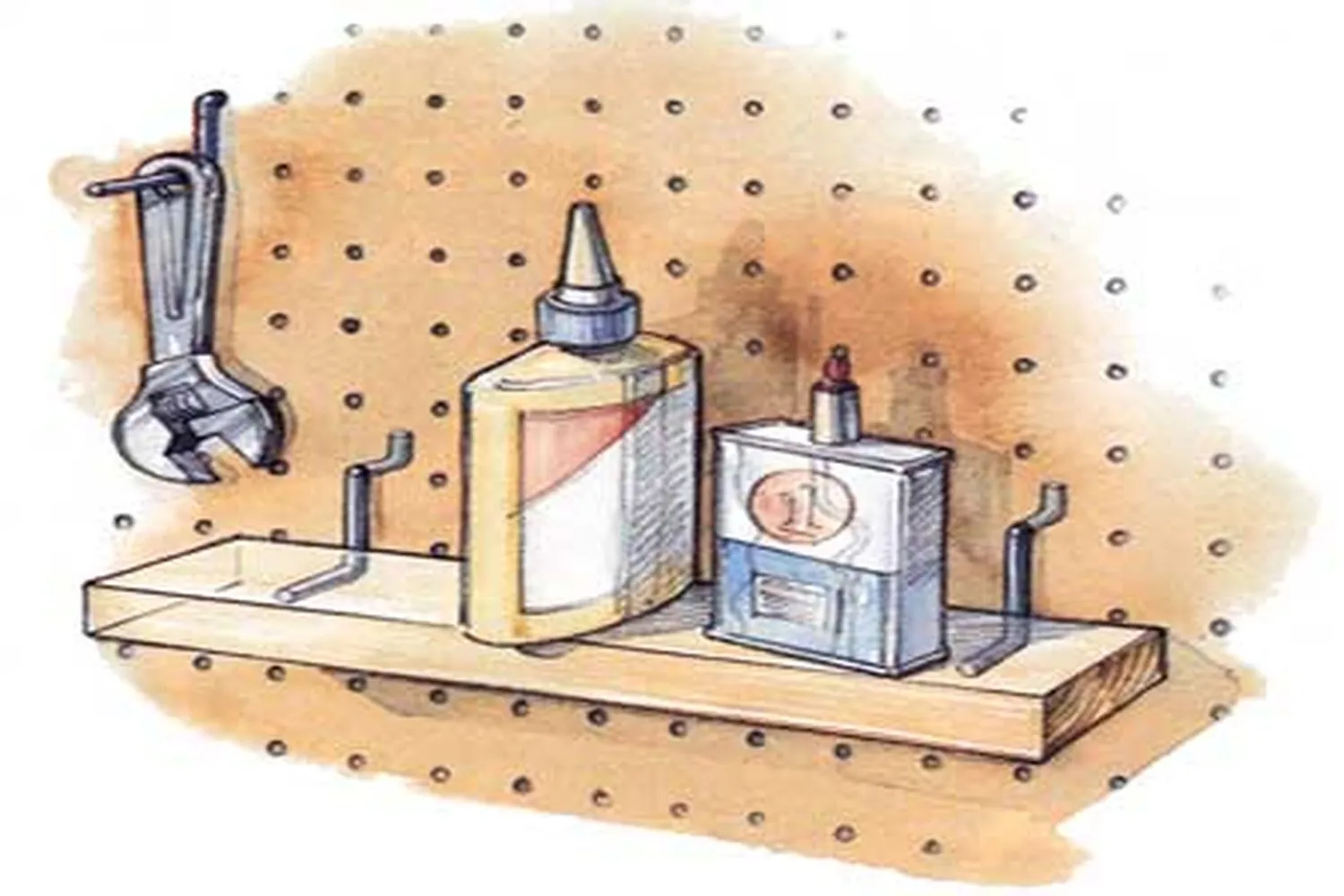Pegboards are versatile tools that can turn cluttered spaces into well-organized, efficient work areas. While most commonly used with hooks for hanging tools, some items require a stable, flat surface. A simple pegboard shelf is an easy DIY project that enhances your workspace, adding functionality and allowing for customization to suit your specific needs. Our guide will walk you through creating a custom shelf for your pegboard, helping you maximize your storage and keep your space organized.
Supplies Needed for a DIY Pegboard Shelf
This simple shelf requires minimal supplies, making it an easy and cost-effective addition to your pegboard. You’ll need the following supplies for your pegboard shelf installation.
- Measuring tape
- Pencil
- Saw (hand saw or power saw)
- Drill with 3/16-inch drill bit
- Sandpaper (optional)
- Level
- 1×4 pine board (10 inches long)
- Two short, straight pegboard hooks
- Wood glue (optional)
Step-by-Step Guide to Creating Your Pegboard Shelf
Follow these simple steps to create your custom pegboard shelf in just a few minutes.
Step 1: Measure and Cut the Wood
- Measure and mark a 10-inch length on your 1×4 pine board.
- Using your saw, carefully cut the board to size.
- Sand the cut edges if desired for a smoother finish.
Step 2: Drill Holes for Pegboard Hooks
- Measure and mark 1 inch from each end of the cut board along the back edge.
- Using your drill with a 3/16-inch bit, bore holes at the marked spots.
- Make sure the holes are at least 1 1/2 inches deep to hold the pegboard hooks securely.
Step 3: Install the Shelf
- Insert a short, straight pegboard hook into each drilled hole.
- Apply wood glue to the hooks (optional), then align them with the pegboard holes and insert them.
- Gently press down on the shelf to secure them in place.
Maximize Your Pegboard’s Weight Capacity
The weight capacity of a pegboard depends on several factors:
- Pegboard material: Metal pegboards generally offer the highest strength and durability, followed by hardboard and plastic.
- Thickness of the board: Thicker boards typically handle more weight and are less likely to bend or warp than thinner boards.
- Number and type of fasteners used: Using more fasteners and choosing appropriate types for your wall material can increase the stability and load-bearing capacity of the pegboard.
- Weight distribution: Evenly distributing weight helps prevent localized stress that can lead to bending or damage.
A standard 1/4-inch hardboard pegboard can generally hold between 50 and 100 pounds when properly installed. However, it’s best to consult the manufacturer’s specifications for your pegboard.
Reinforcement Techniques
Use the following reinforcement techniques to increase your pegboard’s weight capacity:
- Attach heavy-duty hooks specifically designed to accommodate larger weights.
- Choose metal peg-boards for heavier loads.
- Distribute weight evenly across the board rather than concentrating it in one area.
- Install furring strips behind the pegboard for added support.
- Use more fasteners when mounting the board to the wall.
Creative Uses for Your New Pegboard Shelf
Below are some creative ways to make the most of your custom storage solution.
Storing Workshop Essentials
Use your shelf to keep frequently used items within easy reach, including:
- Glue bottles and adhesives
- Measuring tools like tape measures or calipers
- Safety gear such as goggles or earplugs
- Small jars of nails, screws, or other fasteners
- Spray paint cans
Organizing Craft Supplies
If your pegboard is in a craft room, consider using the shelf for the following essential items:
- Brushes and other applicators
- Paint bottles or tubes
- Scissors and cutting tools
- Small containers of beads, buttons, or other embellishments
- Spools of ribbon or twine
Maintaining and Upgrading Your Pegboard System
To keep your pegboard organization system functioning optimally:
- Clean the board and accessories periodically to prevent dust buildup.
- Consider adding lighting to improve visibility in your workspace.
- Rearrange your tools and shelves occasionally to accommodate changing needs.
- Upgrade to stronger hooks or custom accessories as your needs evolve.
Annual Maintenance
Perform annual maintenance on the following areas:
- Check for rust or corrosion if using metal pegboards and hooks.
- Reorganize and declutter to maintain optimal functionality.
- Verify the stability of the pegboard and shelving units.
- Regularly inspect the board and hooks for signs of wear or damage.
Alternatives to Traditional Pegboard Shelving
While our basic pegboard shelf offers a practical solution, you can explore additional options to enhance your wall-mounted storage system.
Wall-Mounted Track Systems
Track systems consist of horizontal rails mounted to the wall, with various attachments like shelves, bins, and hooks that can be easily moved and reconfigured. These systems offer flexibility similar to pegboards but with a more modern aesthetic.
Magnetic Tool Holders
Magnetic strips or bars can be an effective alternative to pegboard hooks for metal tools. They keep tools visible and easily accessible while providing your workspace with a sleek, minimalist look.
Vertical Storage Solutions
Vertical storage solutions can be excellent alternatives to pegboard shelving. Options such as slatwall panels or vertical lumber racks can provide additional storage space, improving organization in your workspace. These options help you maximize your wall space, creating an efficient and tidy work area.

